
Tesla’s Model S and Model 3 provide drivers with either a taste of veteran performance or refreshing innovation and value. Both combine to form the US automaker’s line of electric sedans, although they share more of their mechanical makeup with their respective assembly-line SUV partners. Below is a comprehensive breakdown comparing old and new to help you decide which sedan may be the Tesla for you.
What is Tesla Model S?
The Model S sedan is Tesla’s longest-running EV in production to date. It made its official debut in 2012 after years as a prototype for the automaker. Since then, the sporty EV has reigned as the best selling plug-in electric in both 2015 and 2016. Furthermore, after Motor Trend magazine named the 2013 Tesla Model S its “car of the year,” it followed up in 2019, naming it the ultimate “car of the year” for the magazine’s entire history. Sales of the veteran Tesla have slowed since the launch of the automaker’s more cost-friendly Model 3 and Model Y EVs, but the Model S still sits as a premiere sedan that offers a variety of luxury and performance for those who can afford it.
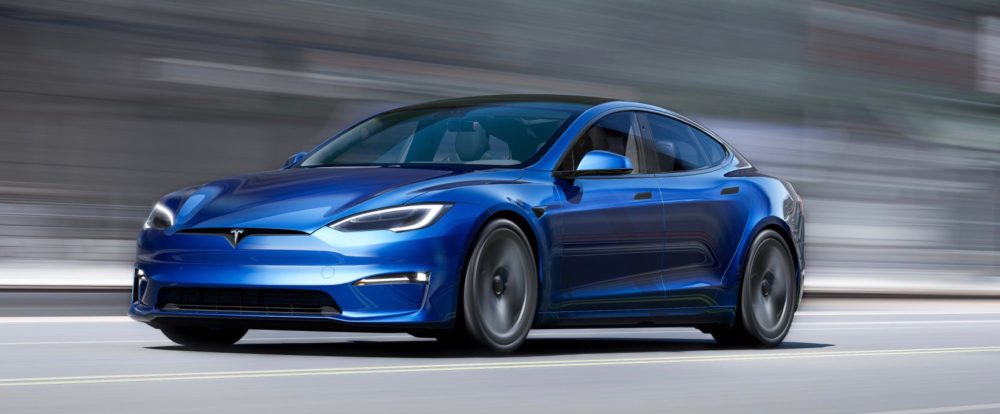
Tesla’s Model S did not see a full refresh in 2020, but Tesla kicked off the new year with a full refresh to both its Model S and Model X vehicles. The automaker has now refreshed the dual motor AWD Long Range trim for customers. Furthermore, Tesla has dropped its Performance trim for two tri motor AWD Plaid variations.
What is Tesla Model 3?
From the early years after Tesla’s inception, CEO Elon Musk was candid about the automaker’s goal of providing quality EVs most consumers could afford to drive. With 2016’s announcement of its Model 3 sedan, Tesla came one step closer to its goal of an EV at $35,000.
After an encouraging number of early reservations were made for Tesla’s most affordable model to date, the Model 3 debuted in 2017. Since then, it has cruised comfortably in the fast lane of sales. The EV currently sits as the world’s best selling all-electric vehicle and has accounted for a majority of the total Teslas sold in recent years.
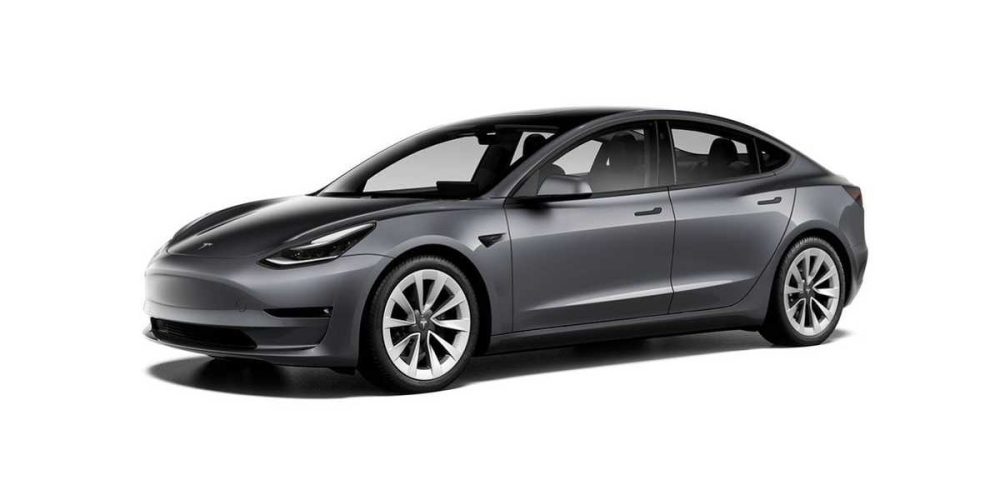
Tesla (briefly) sold a $35,000 version of the Model 3 to hit a price point originally promised by Elon Musk in years leading up to the first delivery. In November, however, Tesla quietly removed this option during a refresh for its 2021 Model 3. The latest version sits at a purchase price of $38,490 for the Standard Range Plus trim with zero added features.
Performance
First we will focus on how these two Tesla vehicles compare in terms of range and speed. Keep in mind that the Model 3 was built as a more affordable Tesla sedan compared to the high-end Model S, so Tesla had to make some sacrifices somewhere. That being said, Tesla’s most affordable EV still has plenty to offer drivers, so let’s begin there.
Model 3
Tesla’s Model 3 currently sells three separate drivetrains to choose from, each offering various ranges and speeds based off a customer’s preferences (and budget). The most affordable trim, the Standard Range Plus, travels an EPA estimated 263 miles, has a top speed of 140 mph, and can travel 0-60 mph in 5.3 seconds. Moving up the ladder to the Long Range trim, this version can travel 353 miles per charge and has a top speed of 145 mph. Furthermore its 0-60 time is 4.2 seconds flat. The Performance Model 3, on the other hand, sheds 38 miles of range compared to the Long Range (315 miles) in favor of speed. This trim tops out at 162 mph and can dart 0-60 mph in just 3.1 seconds.
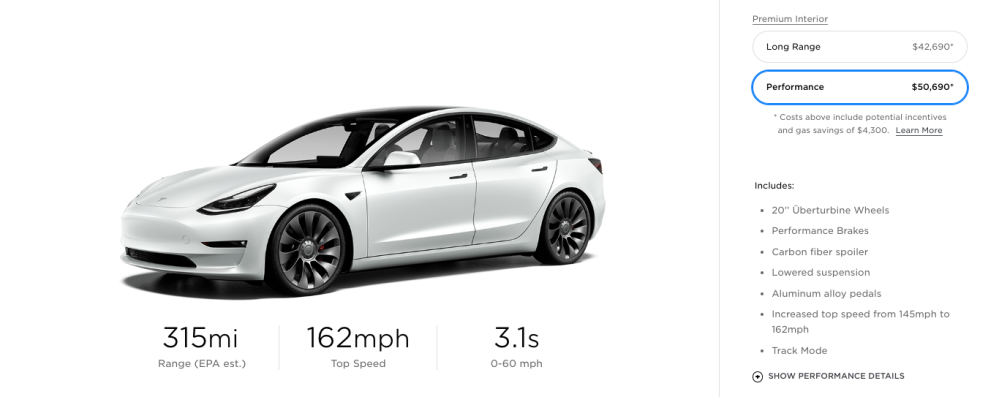
Model S
The least expensive version of the Model S sedan is still dominant compared to the Model 3. The current Long Range trim can travel 412 miles on a single charge, hit a top speed of 155 mph, and can tear from 0-60 mph in 3.1 seconds. That’s 59 miles further than the Long Range Model 3 on top of 10 mph faster. If your preference is pure speed over range, then you gotta go Plaid.
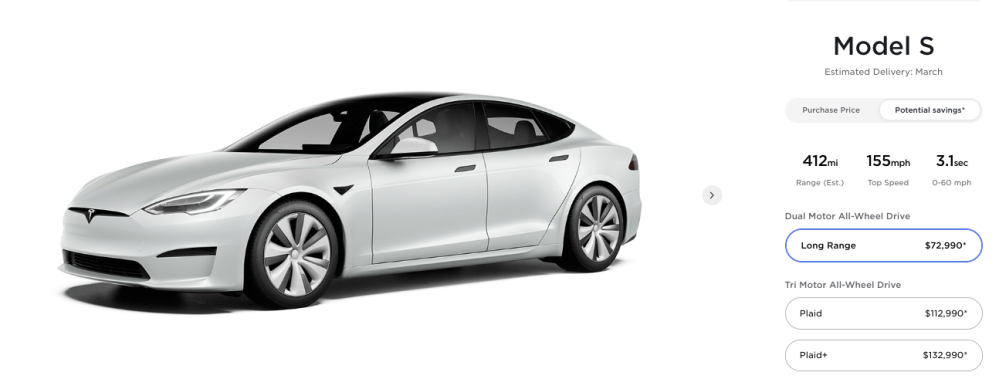
Model S Plaid and Plaid+
That’s not all for the Model S, especially if you have a taste for trying to break track records and the bank simultaneously. This past fall, Tesla confirmed a higher-end version of its banner EV with the unveiling of its tri-motor “Plaid” version.
Tesla recently revealed in its Model S refresh, that the vehicle will now come in either a Plaid or Plaid+ trim with varied range. While the Plaid is not scheduled to begin deliveries until late 2021 (and most fans aren’t holding their breath yet), the initial specs shared by Tesla are quite exciting. For example, Tesla claims the Plaid+ will be able to travel an EPA estimated 520+ miles on a single charge. Either tri motor option can also reach a top speed of 200 mph, blowing a hole through the top speed previously held by its “ludicrous mode.”
What has truly built the hype around the Plaid Model S is its insane acceleration. At 0-60 mph in under 2 seconds, this upcoming Tesla EV has already claimed the throne of quickest of any production car ever. Trust that when Plaid does start leaving burn marks around the globe, Electrek will try to get its hand on one and see what this Tesla can really do.
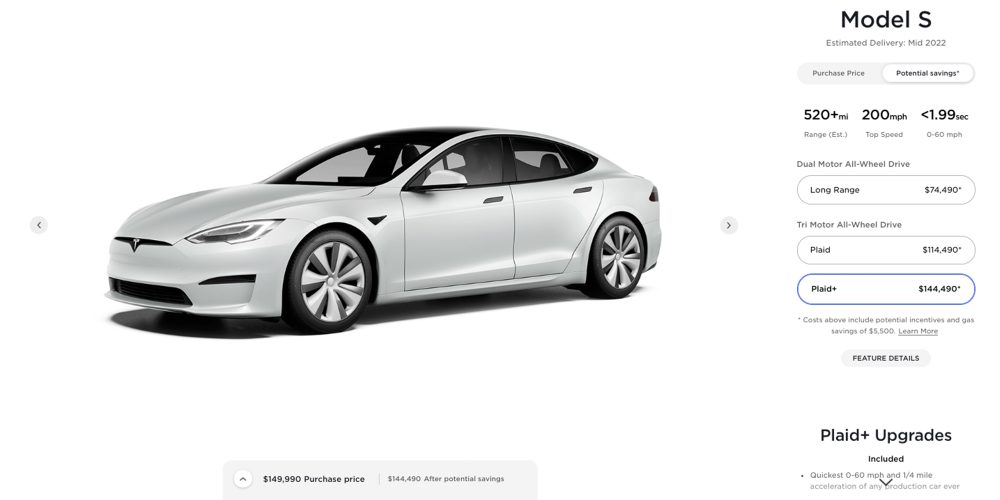
Interior
As the smaller, more streamlined alternative to the Model S, Tesla’s Model 3 tends to lack the space and luxury of its predecessor. That being said, the Model 3’s multiple updates for 2021 have helped the young EV gain ground on its siblings. Even with recent updates, the Model S still bests the younger EV with a 17- inch horizontal touchscreen (two inches larger than the Model 3). The Model S also wins in cargo space, offering 28 cubic feet of space compared to just 15 cubic feet on the Model 3. Lastly, the Model S comes equipped with a HEPA air filtration system to prevent viruses (rather relevant these days), bacteria, pollution, and odors from entering the cabin.
Model 3 interior updates
Now, we’re not here to rain on the Model 3’s parade, as its interior still has plenty of features for drivers. From a recent report from Electrek, Tesla’s Shanghai Gigafactory has already begun producing Model 3 EVs with further updated interiors. This includes a heated steering wheel and a new wood accent expanding from the dashboard to the door panels coming standard. According to our own Tesla guru Fred Lambert:
However, like it has been the case with previous Tesla options, we believe that the hardware is becoming standard and Tesla is likely to offer the heated steering wheel option as a software upgrade through its mobile app to buyers of the cheaper version of the vehicle.
While these changes are currently only reflected in the Model 3 made-in-China, we expect Tesla to make those changes to the Model 3 vehicles produced in Fremont in the coming weeks and months — making them accessible to North American customers.
As you can see below, the wood accent is already a feature for the Model Y on Tesla’s Chinese site. It’s only a matter of time before these features make their way to the similarly designed Model 3 and its Gigafactories worldwide. We will keep an eye out for updates as they emerge.
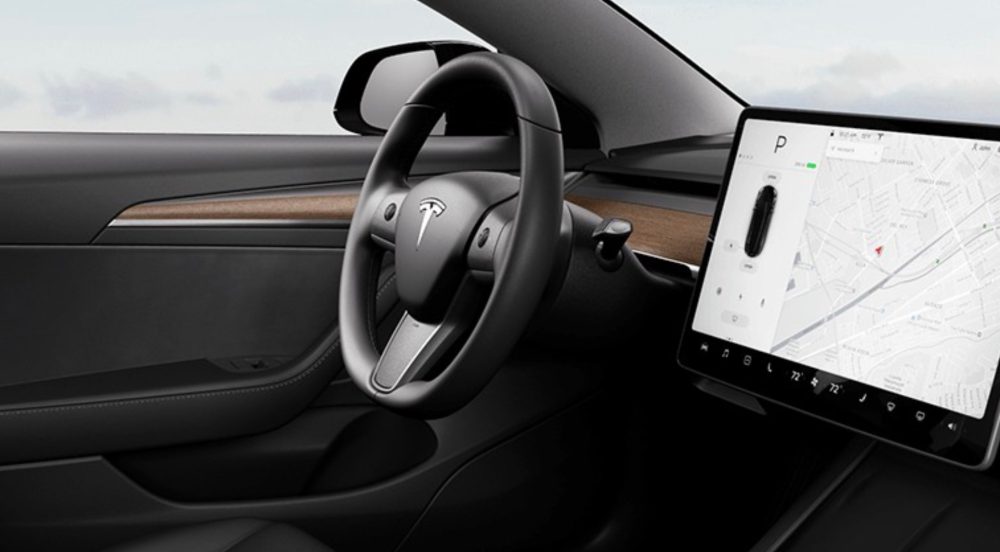
Exterior
The glaringly obvious difference between Tesla’s two sedans is size. The Model S is a larger, heavier machine, but as a result, offers more performance. On top of that, the Model S comes with 19″ or 21″ performance wheels compared to 18″ or 19″ options on the Model 3. Up top, either option comes with a tinted glass roof, offering all passengers ultraviolet and infrared protection.
Moving down the sides, the Model 3 has adopted a style feature first introduced on the Model Y called “chrome delete.” Speaking of chrome delete, that was one feature previously spotted on a potential 2021 Model S refresh near Tesla HQ. The Model S features a wider body, new headlights, and updated wheels. This has now been confirmed in the aforementioned refresh and exists amongst all four current Tesla models.
Drive
Yes, the Model S is an overall faster ride on the stat sheet and is sure to blow the Model 3 off the starting line when its Plaid powertrain eventually makes its debut. With that said, the Model 3 still offers impressive acceleration and top speed on top of extended range, depending on the drivetrain you choose. The increase in range is partially due to the implementation of Tesla’s own designed heat pump, first introduced in the Model Y. With the latest refresh, the heat pump is now present in all of Tesla’s EVs. While the heat pump does offer increased range, there have been recent reports of issues during cold weather that might be caused by this new heat pump, although that has not been confirmed.
Prices
After reading the breakdown of both sedans above, it should be clear that while both Teslas have their differences, both have a lot to offer consumers inside and out. What’s the best option for you, though? It may still be a tough decision up to this point, but truthfully, a large differentiator in this equation is price. Here’s a quick summary of the price ranges of each trim on either model to help offer perspective as to what your ideal Tesla sedan might cost you.
Note that these prices are accurate as of the publish date, and we’ll keep them updated for you moving forward. Furthermore, all prices do not include the additional $1,200 in fees for destination and documentation.
Model 3
Let’s begin with the younger of the two options. The Model 3 Standard Range Plus trim comes with single motor RWD and begins at a purchase price of $39,490. It’s important to note that these base prices are with zero upgrades, and come with the standard white exterior paint. The Standard Range Plus can go as high as $53,990 if you were to add every top feature available. This includes red exterior paint, 19″ sport wheels, black and white interior, and full self-driving capabilities (FSD) for an extra $10,000.
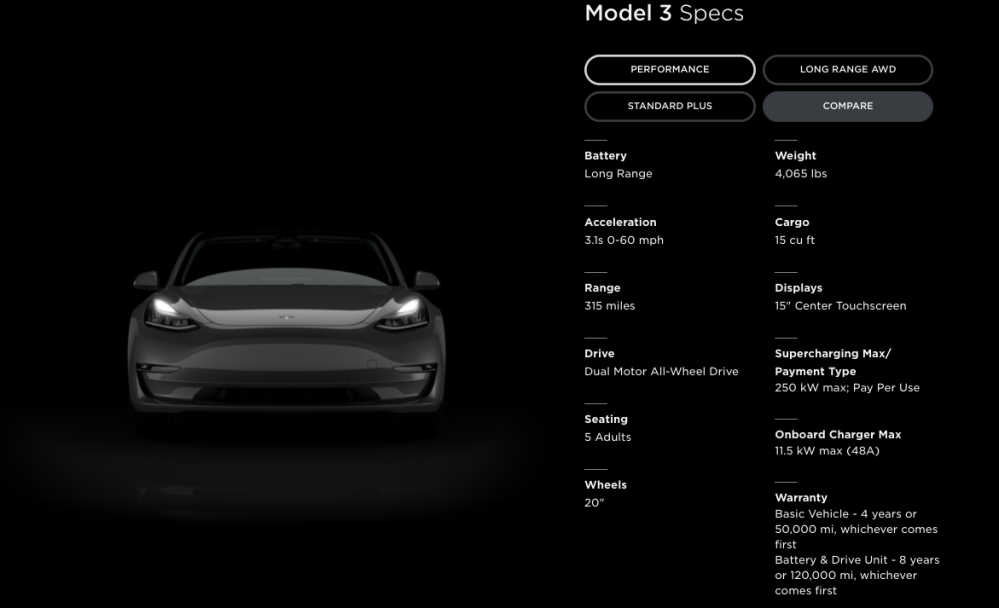
Moving to the dual motor AWD trims, the Long Range Model 3 starts at $48,490 and can go as high as $62,990 with all added features. Last but certainly not least, the Performance version of the Model 3 begins at a purchase price of $56,990 and can soar to $69,990 with all the toppings. Overall, your least costly option for a new Model 3 comes in just under $39,000, while the most expensive version will run you almost $70,000. It’s worth noting these are the full purchase prices on Tesla’s website and do not include any discounts such as money saved on gas or tax incentives.
Model S
Compared to the Model 3, Tesla’s Model S starts a couple price tiers higher and only elevates from there. Remember, the Model 3 is Tesla’s most affordable vehicle, while the Model S is its second most expensive. Starting with the Long Range trim, this Model S starts at $79,990 completely standard. If you were to add each and every additional feature such as red paint, 21″ Arachnid Wheels, custom interior, and FSD capabilities, you’re looking at a price of $98,990. If you’re sweating and clutching your wallet after those numbers, just wait until you read about the Plaids.
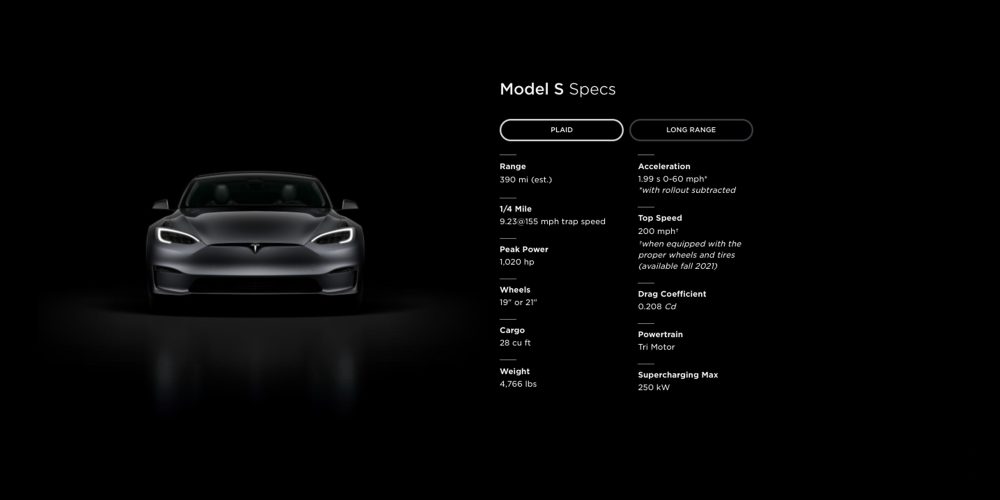
Tesla’s tri-motor Model S Plaid powertrain hasn’t even made a single delivery yet, and when that first delivery may be still remains uncertain. Regardless, Tesla has already received a number of pre-orders for this beast of a vehicle along with a price to match its unmatched performance. Look at a brand-new white Plaid Model S with zero upgrades, for example. That Tesla starts at $119,990 standard. To truly drive this price point home for you all, we’ll add all of the available and most expensive features.
With red paint, new 21″ Arachnid Wheels, and FSD capabilities, the Plaid can cost a whopping $138,990. That’s not all, though. The new Model S Plaid+ offers the same Plaid speed but with 520+ mile range. This bad boy starts where its counterpart left off at 149,990, then soars to 168,990 with all add-ons including a possible second mortgage.
For added texture, the fully loaded Model S Plaid+ will cost you nearly $100,000 more than a fully upgraded Model 3 Performance. Better yet, you could purchase two of those high-end Model 3s and still have $29,000 left over for whatever you’d like. Perhaps a couple of quality ebikes to continue your carbon-conscious preference for transportation?
What’s better? Tesla Model S or Model 3?
Like any Tesla purchase, the decision is not so simple. As Tesla’s veteran vehicle, the Model S offers size, cargo, and unmatched performance, but at a higher price. The latest refresh has only solidified these benefits for years to come, but with additional costs to an already expensive model.
While the Model 3 is certainly smaller and a bit slower off the line in comparison, it still offers respectable range and performance at an unmatched price. This is a huge reason why the Model 3 has quickly become the best-selling plug-in electric in history. For purchase price alone, the Standard Range Plus Model 3 is a clear winner. For overall value, either dual-motor trims of the Model 3 take the cake. As a newer model and a clear focus of the automaker looking forward, the Model 3 has already seen several upgrades to its design and performance. Expect more of this in the future as an owner.
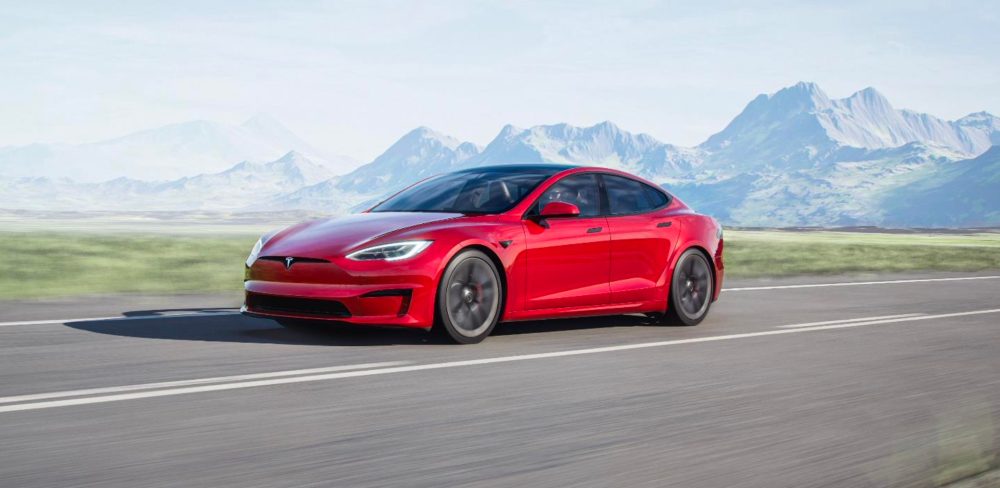
Overall, you can’t go wrong with either Tesla, and the biggest deciding factor really comes down to how much you want to spend. If you’re new to the electric vehicle world, why not start with a Model 3? Want a little more speed and luxury? Go with the Model S. Lastly, if you have $170,000 lying around collecting dust, maybe put in an order for that insane tri-motor Plaid+ Model S.
Subscribe to Electrek on YouTube for exclusive videos and subscribe to the podcast.
Author: Scooter Doll
Source: Electrek



